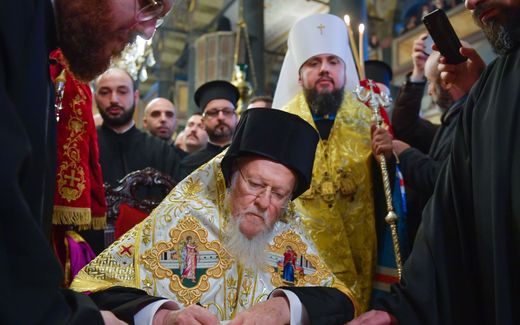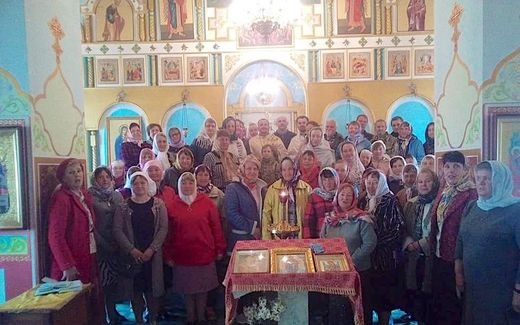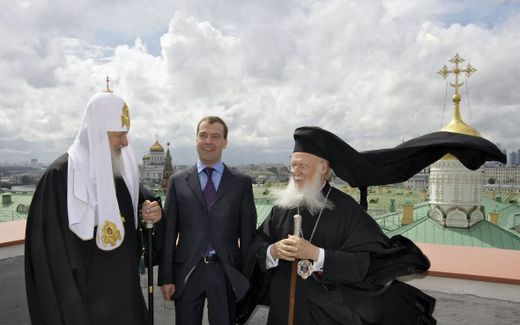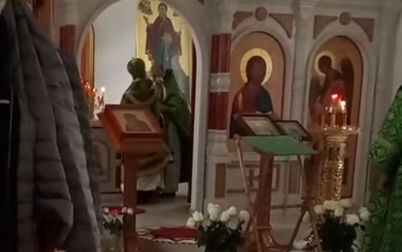No peace between Orthodox churches in Ukraine yet
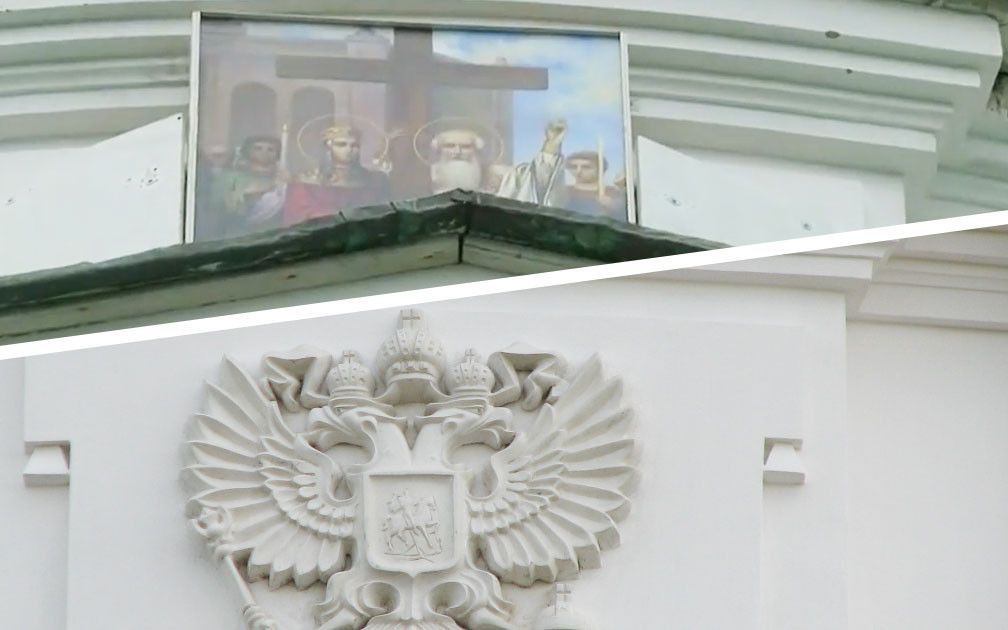
The stone image on a monastery in Ukraine irritated people since it has the Russian eagles. An icon covers the image now. Photo Facebook
Eastern Europe
The Holy Cross Monastery in Poltava (northeast Ukraine) has a lovely stone image on the bell tower, with a double-headed eagle. But it is a pity that this is the symbol of the Russian Federation. For the patriotic Ukrainians, this ornament is seen as a betrayal. This started the debate on what to do with the stucco image.
The regional official Oleg Pustovhar asked to demolish the eagles from the bell tower. According to him, this symbolises the satanic Kremlin empire and, therefore, a threat to the country. On top of that, the thought the image is a shame for the old monastery, built in the 17th century.
Pustovhar represents the Ukrainian Institute of National Remembrance in the region of Poltava. He officially addressed the government for this, Poltava Oblast News reported.

But the stone image was not demolished. Instead, it was covered with an icon, entirely in the style of the Eastern Orthodox Church.
Complicity with crimes
The incident regarding the monastery in Poltava is just one example of the ever-present sensitivity between the different Orthodox churches in Ukraine. Initially, there was just one church: the Ukrainian Orthodox Church (UOC), which stays in contact with the Moscow Patriarchate (MP) of the Russian Orthodox Church (ROC). Especially since the war started, this church has been accused of complicity with Russian crimes.
But in the years after the Ukrainian national independence in 1991, other Orthodox churches grew. Some of them were united in 2018 when the Patriarchate of Constantinople (the ‘Pope’ of all the Orthodox churches worldwide) recognised the autonomy of the so-called Orthodox Church in Ukraine (OCU, sorry for the like-minded abbreviation).

The teaching and the liturgy in the churches are the same. But in the OCU might be more space for the Ukrainian language, while in the UOC, the Old Slavonic is dominant.
The decision in 2018 was mainly a political move. It was the then-President Poroshenko who was behind it. Poroshenko can be seen as a Ukrainian nationalist since he also introduced legislation to discourage the use of the Russian language.
Both the language and the church politics stimulated tension with Russia. In the Orthodox understanding of a church, having two spiritual bodies with the same legality is impossible. Since then, the church issue has been at the core of the Russo-Ukrainian conflict.
Last May, the UOC tried to distance itself from Russia by deleting all the references to the Moscow Patriarchate from the statutes. But it is clear that this did not stop the identification of the UOC with the ROC (the church in Russia). And officially, the UOC still falls under Patriarch Kirill in Moscow.
The head of the UOC, Metropolitan Onuphry in Kyiv, has never kept silent about his resistance to the Russian invasion. The official church’s website speaks about “Russia’s military aggression” and calls the war a “grave sin against God’s law and a crime against the lives of citizens of Ukraine”. From the first day of the war, the UOC surprised the world with heavy criticism of the hostility from the Russian brothers.
But on the other hand, the UOC sees itself as the only true Orthodox church in Ukraine. This also means that this body represents all the dioceses in the country of Ukraine, although many parishes say they stepped over to another Patriarchate. In this, the UOC follows the Russian church. Last week, the Russian press agency RIA Novosti wrote that the Ukrainian OCU is “formed by schismatics, and therefore is not a church in the canonical sense.”
In reverse, the same is said by Patriarch Bartholomew of Constantinople, who claims that the OCU is “the only canonical Orthodox Church on the territory of the Ukrainian state”, as Religion Pravda writes.
Priest with armed guards
How sensitive this issue between the Orthodox churches is, became clear on the Friday afternoon of August 6th. Volodymyr Lutskov, the head of a community in Piskivka, a village northwest of Kyiv, was visited by the local priest. But the man was not alone; armed guards in camouflage clothing accompanied him. The priest –with the paramilitaries in the back– said he came for a “peaceful resolution” of a “religious issue”.

According to the newspaper RBC, the visit came after a debate in the village council whether the local church should belong to the new OCU (under the Patriarch of Constantinople) or the old UOC (under the Patriarch in Moscow). A few days before the visit, the issue had been on the table whether the local church should disconnect from the Moscow Patriarchate. Lutskov: “We are all united in the desire to get rid of this unclean thing in our land.”
The priest said later that the paramilitaries were not to intimidate Mr Lutskov; they were just parishioners who protected the church. It is not clear whether it is so innocent. In July, an incident at the funeral of a fallen soldier occurred when a priest of the UOC MP beat a clergyman of the OCU with a cross, as RBC reports.
Another sensitivity was reported this week by Archdeacon Andriy Palchuk from Odessa. It had irritated him that a billboard with the Metropolitan Epiphany, the head of the UCO, was placed in the neighbourhood of the Transfiguration Cathedral in Odessa. The deacon sees Epiphany as a schismatic. The church in the south of Ukraine has another leader, and he questions the goal of the billboard in the city, as was reported by the Union of Orthodox Journalists.
Support for Moscow is sinking
The Moscow-related church still rules the great majority of the parishes in Ukraine. 12,000 local churches fall under an “MP” priest of the UOC, while 7,500 parishes have a priest from the OCU.
The truth, however, is that the population’s sympathy is switching towards the independent OCU. According to a recent opinion poll from the Kyiv International Institute of Sociology, the support for the Moscow Patriarchate has shrunk to 4 per cent (it was 15 per cent in 2020). The support for the new Orthodox Church of Ukraine has grown to 54 per cent (34 per cent in 2020). All over Ukraine, 72 per cent of the people identify themselves as Orthodox.
(Other remarkable results: atheism has grown from 8 to 10 per cent, especially among young people in the East. Protestants are stable at 2 per cent. The Greek Catholics remain at 8 per cent.)
For the traditional, Russian-oriented churches, these numbers are devastating. It shows that many churchgoers come to a local church that belongs to another branch of the church than they actually prefer. Even among Russian-speaking Ukrainians, 36 per cent identify with the OCU (against 13 per cent in favour of the Moscow-related church).
Banning the Moscow church
In the last few months, many local churches moved from the Moscow-oriented UOC to the Constantinople-oriented OCU. It is clear that the political pressure to do this is intense.
This week, the Baranivka Town Council (in the Zhytomyr region, west of Kyiv) decided to “ban” all activities of the UOC. The council took this step “to prevent threats to the national security of the country during martial law”, as was reported by the Union of Orthodox Journalists.
Comeback to the church

Two weeks ago, it was reported that the archpriest Volodymyr Litvenchuk returned to the Russia-oriented UOC after spending a short time in the OCU. Initially, he thought the most logical step to make clear that he was against the war was to leave the Russo-Ukrainian church. But soon, he discovered that the independent UOC was full of politics and did not satisfy him spiritually. After asking for forgiveness in a meeting with Metropolitan Onuphry, he returned to the UOC, as he told his story to the church’s website.
The UOC nevertheless seems open to unity with the other church since people are still gathering to pray for reconciliation.
Related Articles


